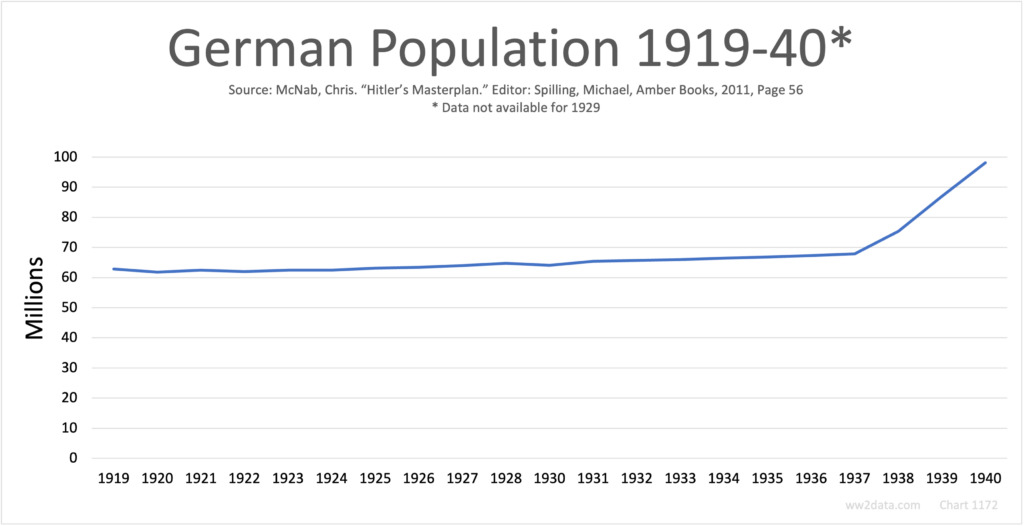Germany’s population post The Great War averaged year-over-year growth of 0.4% between 1919 and 1937. However, with the annexations of Austria, Sudetenland, and the Czechoslovak Republic the 1938-40 average year-over-year growth was 13.1%. The period between World War I and World War II witnessed significant demographic changes in the German population. These changes were influenced by various factors, including the aftermath of the Great War, territorial annexations, and political developments. However, it was the annexations in the late 1930s that was the real driver of population growth. This article explores the fluctuations in Germany’s population from 1919 to 1940, shedding light on the key events and circumstances that shaped these demographic trends.

The above graph can be downloaded as an image.
Table of Contents
Pre-World War I: 1910 German Population
At the outset of the 20th century, Germany’s population as indicated by the 1910 census, recorded 64,925,993 people. This period was characterized by rapid industrialization and urbanization, with Germany becoming one of Europe’s leading economic and military powers.
Post-World War I German Population
The Impact of the Great War
Following the devastation of World War I, Germany experienced a decline in its population. The 1919 census revealed a population of 60,898,584, reflecting the toll of the conflict on both military and civilian lives. Additionally, Germany ceded territories such as the northern section of the Schleswig Plebiscites to Denmark. The aftermath of the war brought severe economic challenges, political instability, and social unrest, all of which contributed to this demographic downturn.
1939 Census: Growth by Annexation
By 1939, as Europe once again teetered on the brink of war, Germany’s population had rebounded significantly. The census of that year recorded a population of 79,375,281, signifying a substantial increase compared to the post-World War I period. Several factors contributed to this population growth:
1. Annexations:
Germany’s territorial expansion played a pivotal role in its population increase. The annexation of neighboring regions contributed substantial numbers to the German population. Notable annexations included:
a. The Federal State of Austria (Anschluss):
On 12 March 1938, Germany annexed Austria in an event known as the Anschluss. This union created a “Greater Germany” and integrated Austria’s population into the Reich. The annexation of Austria was a significant factor in the population surge of 1939.
b. Sudetenland:
The German annexation of the Sudetenland in 1938, a region of Czechoslovakia with a significant German-speaking population, further contributed to the demographic growth of Germany. This annexation was achieved through diplomatic agreements, notably the Munich Agreement, which followed the policy of appeasement.
c. Protectorate of Bohemia and Moravia:
Following the disintegration of Czechoslovakia, Germany established the Protectorate of Bohemia and Moravia in 1939, incorporating these territories into its sphere of influence.
2. Appeasement:
The policy of appeasement pursued by Western powers in response to Germany’s territorial ambitions allowed for the annexations to occur relatively peacefully, further fueling the demographic growth.
These annexations expanded the geographic reach of Nazi Germany and added significant populations to its ranks, contributing to the population figures of the 1939 census.
Summary
Germany’s population between 1919 and 1940 experienced fluctuations influenced by the aftermath of World War I, territorial annexations, and geopolitical developments. The population growth of 1939 was closely tied to the annexations of Austria, the Sudetenland, and the establishment of the Protectorate of Bohemia and Moravia, all of which reshaped the demographic landscape of Nazi Germany during this critical period of European history.
German Population 1919-40 Data
To download the data shown below from which the graph was developed click on the icon below corresponding to you desired format. Note: to ensure all data is downloaded choose the ‘All’ selection in the Show Entries dropdown list. Otherwise only the data visible on the screen will download.
*Data not available for 1929
Source: McNab, Chris. “Hitler’s Masterplan.” Editor: Spilling, Michael, Amber Books, 2011, Page 56
Other Population and Demographic Data
World Population by Country by Alignment – 1939
This website, ww2data.com, has no responsibility for the persistence or accuracy of URLs for external or third-party internet websites referenced. Nor does ww2data.com guarantee that any content on such websites is accurate or will remain accurate.

Leave a Reply